Sudoku Puzzle #42
by: Dan LeKander
This month we return to a Sudoku puzzle format that will be most recognizable to you. As always, the puzzle will require a keen eye!
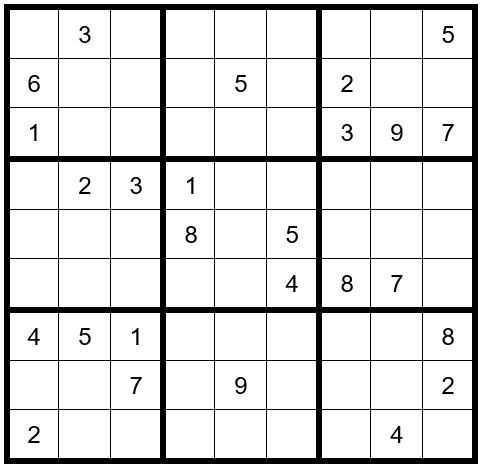
DAN’S 8 STEP APPROACH TO SOLVING ALL SUDOKU PUZZLES
Once you have completed the puzzle, to the extent that you have filled-in all obvious answers and have written all potential options across the top of the unsolved cells (PUZZLE PREPARATION), Dan recommends the following Steps to complete the puzzle.
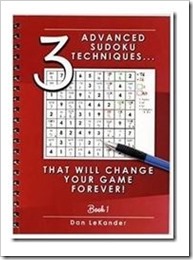
Step 1: Sudoku Pairs, Triplets and Quads – September 2015
Step 2: Turbos & Interaction – October 2015
Step 3: Sudoku Gordonian Rectangles and Polygons – November 2015
Step 4: XY-Wings & XYZ Wings – December 2015
Step 5: X-Wings – January 2016
________________
Step 6: DAN’S YES/NO CHALLENGE
Step 7: DAN’S CLOSE RELATIONSHIP CHALLENGE
Step 8: AN EXPANSION OF STEP 7
Steps 1-5 are relatively common techniques and are explained in the TI LIFE articles above. Steps 6-8 are covered in detail, in Dan’s book.
Also, see Sudoku Puzzle Challenge… February 2016, March 2016, April 2016, May 2016, June 2016, July 2016, August 2016, September 2016, October 2016, November 2016, December 2016, January 2017, February 2017, March 2017 , April 2017, May 2017, June 2017, July 2017, August 2017, September 2017, October 2017 , November 2017 , December 2017, January 2018, February 2018, March 2018, April 2018. May 2018, and June 2018
As a reminder, the basic rules of Sudoku are that the numbers 1-9 must be contained and cannot be repeated in a row, column, or box, and there can only be one solution to the puzzle.
PUZZLE PREPARATION
Prior to utilizing techniques first complete the 4 Steps of Puzzle Preparation …
- FILL IN OBVIOUS ANSWERS
- FILL IN NOT-SO-OBVIOUS ANSWERS
- MARK UNSOLVED CELLS WITH OPTIONS THAT CANNOT EXIST IN THOSE CELLS
- FILL IN THE OPTIONS FOR THE UNSOLVED CELLS
OBVIOUS ANSWERS …
Start with the 1’s to see if there are any obvious 1-choice answers. Then navigate the 2’s through 9’s.
The first obvious answer is C8R5=2 (cell in column 8, row 5). Next, C1R8=3. C4R8=4. C4R9=5. C3R3=5. C1R4=8. C1R6=5. C3R1=2.
Now your grid should look like Example #42.1 below:
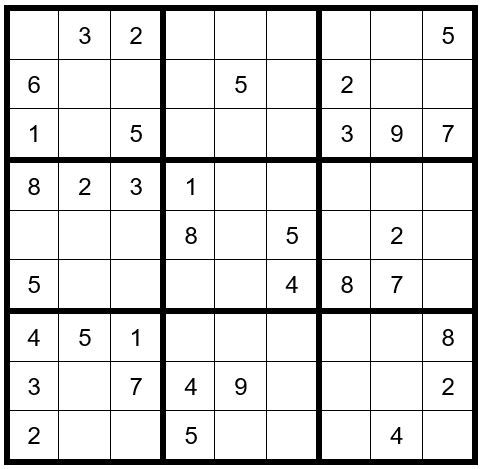
NOT-SO-OBVIOUS ANSWERS …
The only cells in box 6 (right center box of 3x3 cells) that can be a 3 are C9R5 & C9R6; therefore, C9R9 cannot be a 3. This leaves only one cell in box 9 that can be a 3. C8R7=3.
The only cells in box 7 that can be a 9 are C2R9 or C3R9; therefore, C7R9 & C9R9 cannot be a 9. This leaves only one cell in box 9 that can be a 9. C7R7=9. Then, C7R9=7.
Now your grid should look like Example #42.2 below:
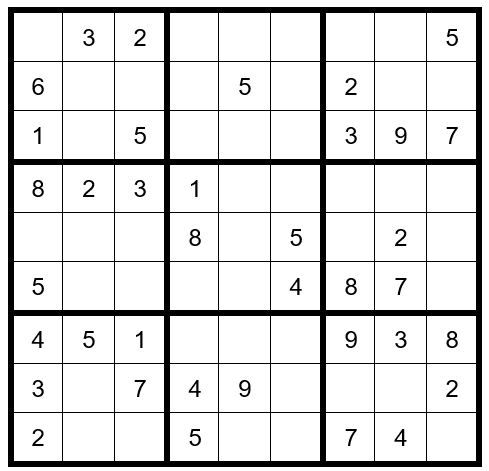
MARK UNSOLVED CELLS WITH OPTIONS THAT CANNOT EXIST IN THOSE CELLS …
In box 4 a 4 can exist only in C1R5, C2R5 or C3R5; therefore, a 4 cannot exist as an option in C7R5 or C9R5. Pencil a small 4 in the bottom of those two cells to indicate they cannot be a 4.
In box 3 a 6 can only exist in C7R1 or C8R1; therefore, a 6 cannot exist in C4R1, C5R1 or C6R1.
In box 4 a 7 can only exist in C1R5, C2R5 or C3R5; therefore, a 7 cannot exist in C5R5.
Now your grid should look like Example #42.3 below:
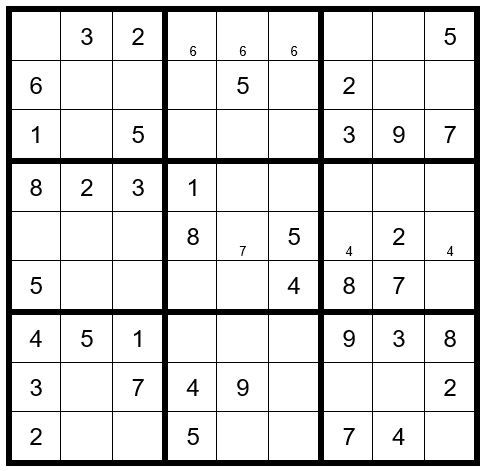
Example #42.3
FILL IN THE OPTIONS FOR THE UNSOLVED CELLS …
Once you fill in the options for the unsolved cells, your grid should look like Example #42.4 below:
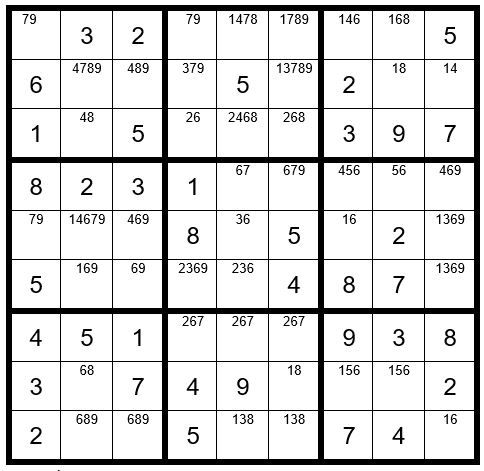
STEPS 1-8
We will begin with Step 1, identifying Pairs, Triplets & Quads. We will search each row, column and box. Can you spot any pairs or triplets in Example #42.4?
The first pair we spot is an obvious pair in row 1. C1R1 & C4R1 can only be a 7 or 9; therefore, we can eliminate the 7 and 9 from any other unsolved cell in row 1. Now that we have removed the 7 and 9 from C6R1 leaving its options as 18, we have created another obvious pair in column 6. C6R1 & C6R8 options are 18; therefore, we can remove the options 1 and 8 from all other unsolved cells in column 6. This leaves C6R9 with just one option. C6R9=3.
We have created yet another obvious pair in row 3. C4R3 & C6R3 have options 26, eliminating the 2 and 6 as options from all other unsolved cells in row 3 and box 2.
We can also find another obvious pair in C4R1 and C6R2, eliminating options 7 and 9 from C4R2. C4R2=3. Now your grid should look like Example #42.5 below:
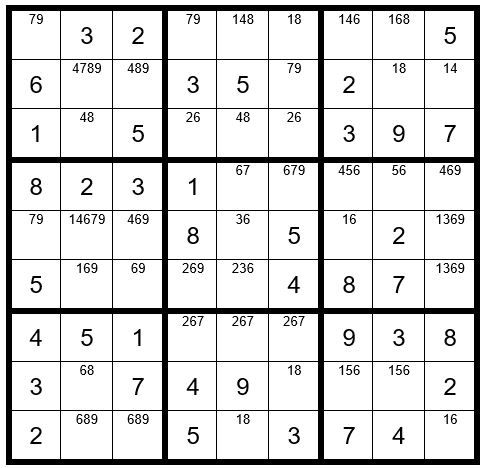
Now we will move on to Step 2: Turbos and Interactions.
Examine box 2. The only unsolved cells that contain the option 1 are C5R1 and C6R1; therefore, one of these two cells must be a 1. That being the case prevents C7R1 and C8R1 from having a 1 as an option.
Now your grid should look like Example #42.6 below:
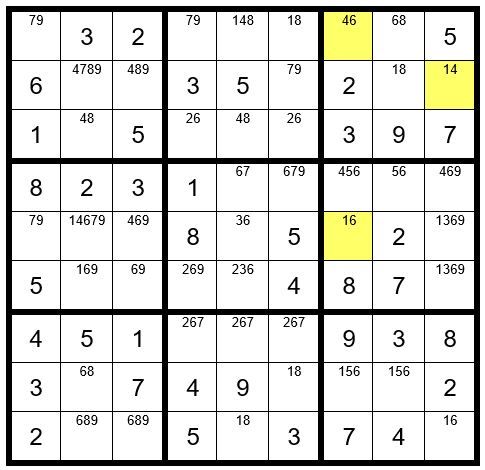
In continuing our search for other Step 2 clues we find no additional clues.
We will move on to Step 4: XY and XYZ Wings. Notice, in Example #42.6 above there are 3 unsolved cells highlighted in yellow. The options for these cells form a triplet, with two of the cells in one box and the other cell in a second box, setting the stage for a potential XY-Wing. The “driver cell” is the cell that is adjacent to the other two cells. C7R1 must be a 4 or 6. If it is a 6, then C7R5 is a 1 and it follows that C9R5 and C9R6 cannot be a 1. If C7R1 is a 4, the C9R2 is a 1 and it follows that C9R5 and C9R6 cannot be a 1. Therefore, regardless if C7R1 is a 4 or 6, C9R5 and C9R6 cannot be a 1, and the 1 can be removed as an option from these two cells. Now there is only one unsolved cell in box 6 that can be a 1. C7R5=1. It then follows that C2R6=1. Now your grid should look like Example #42.7 below:
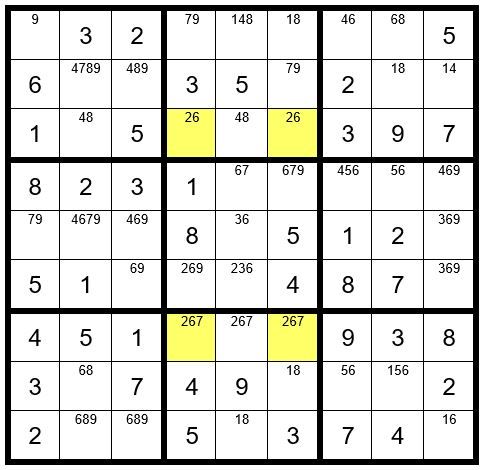
Just noticed a Step 3: Gordonian. Please see the highlighted cells in Example #42.7 above. This is a variation of the 1-sided Gordonian Rectangle. If C4R7 & C6R7 did not contain a 7, you would have four cells with options 26, which would violate the law of Sudoku that you cannot have 2 or more valid solutions to the puzzle. It stands that one of these two cells must be a 7; therefore, C5R7 cannot be a 7, and you can remove it as an option. Now your grid should look like Example #42.8 below:
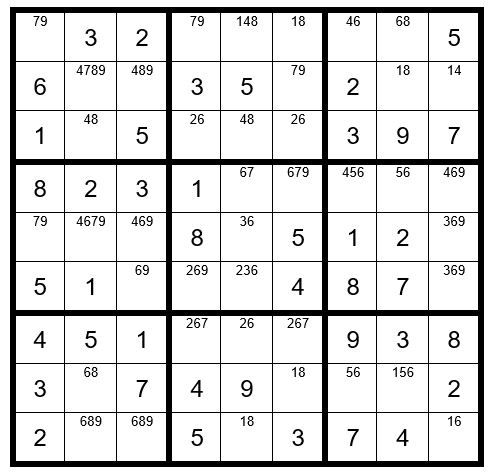
How convenient! We have created an obvious triplet in column 5 with cells C5R5, C5R6 and C5R7, eliminating the 6 in C5R4 (it is also the only cell in column 5 that has a 7 as an option. C5R4=7. Now your grid should look like Example #42.9 below:
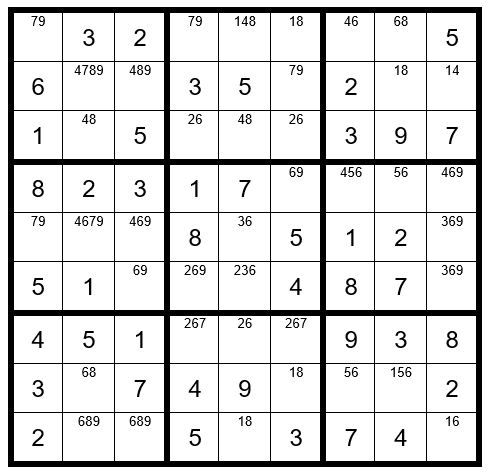
That seems to be the end of the Step 1-5 clues, so we will move on to Step 6: Dan’s Yes-No Challenge.
There are 3 circumstances that establish the potential for a Step 6 exercise:
- Look for just 2 unsolved cells in a box that contain the same option where these 2 cells are not in the same row or column.
- Look for just 2 unsolved cells in a column that contain the same option where these 2 cells are not in the same box.
- Look for just 2 unsolved cells in a row that contain the same option where these 2 cells are not in the same box.
In row 3 we find just 2 unsolved cells that contain the option 8 … C2R3 & C5R3. These cells are not in the same box, thereby qualifying as a candidate for a Step 6 exercise. These cells are highlighted in yellow in Example #42.10 below:
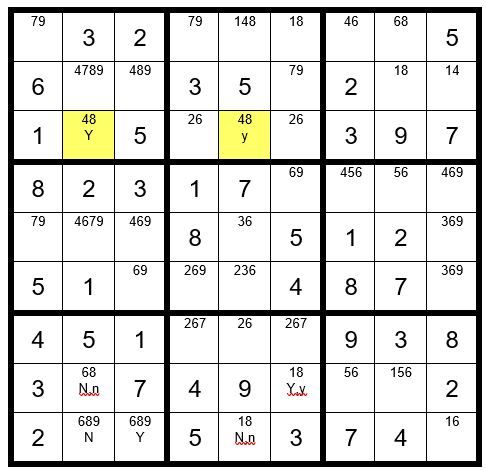
One of these two yellow cells must be an 8. We will consider them as “driver cells” which “drive” the exercise.
Here is the logic. We will perform two exercises. First, we will assume C2R3 is the 8 and see which other cells cannot be an 8. Then we will assume C5R3 is the 8 and see which other cells cannot be an 8.
We will mark C2R3 with a “Y” and mark C5R3 with a lower case “y” to keep track of the exercise as per Example #42.11 below.
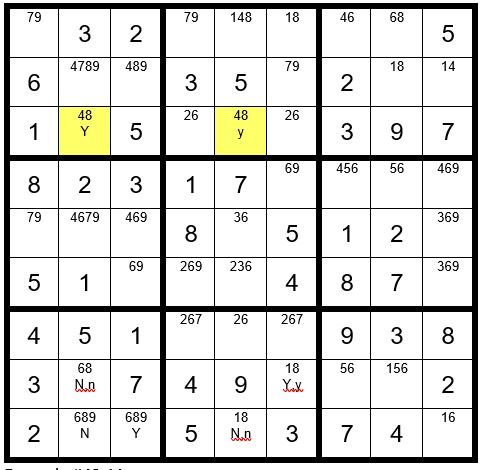
If C2R3=8 (marked with a “Y” for yes), then C2R8 & C2R9 are not an 8 (marked with a “N”). Then C3R9=Y. C5R9=N. C6R8=Y.
Now we will assume C5R3 is the 8. Then C5R9=n. C6R8=y. C2R8=n.
What does it mean if a cell is marked N,n? We know that one of the 2 yellow cells must be an 8. We have gone through the exercise detailing what the other unsolved cells in the puzzle must be, depending on which yellow cells is an 8. So, a cell with a N,n designation means that it cannot be an 8 regardless of which yellow cell is an 8, so you can remove the 8 as an option from cells C2R8 & C5R9. C2R8=6. C5R9=1.
What does it mean if a cell is marked Y,y? Again, regardless of which cell in row 3 is the 8, C6R8 is an 8. C6R8=8.
Now your grid should look like Example #42.12 below:
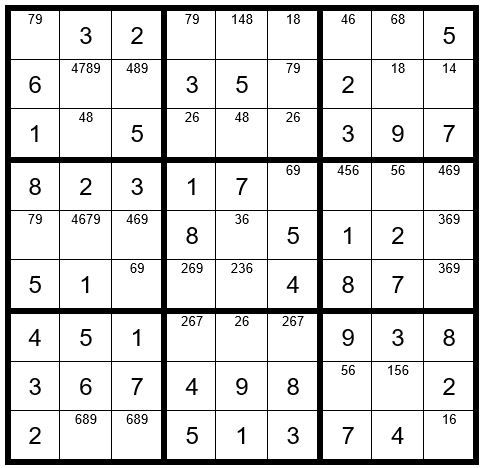
You can clearly see that there are some easy moves from this point. C9R9=6, C7R8=5, C8R8=1, C8R2=8 and so forth to completion.
Your final grid should now look like Example #42.13 below:
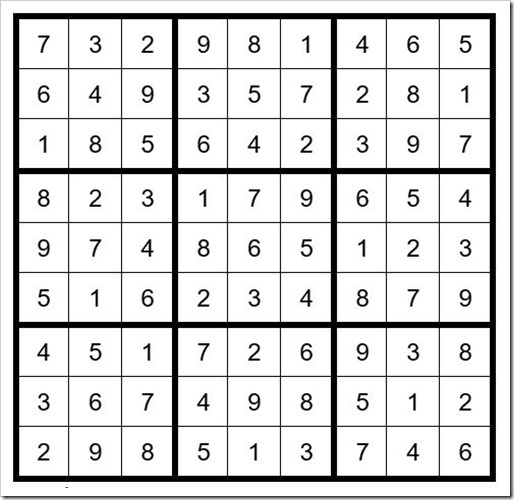
I sincerely hope you have enjoyed working on this puzzle!
May the gentle winds of Sudoku be at your back.
By Dan LeKander
Editor’s note:
Do you tackle a Sudoku on your cottage veranda, sailboat cockpit, or at a campsite? And now in June… how about the beach!

In January 2016, we published a final article in his series – but many of us enjoy using “Dan’s Steps,” so when he asked if we would like a puzzle to solve every month … this editor said an enthusiastic… Yes, please! Now we are three years later and on Puzzle #42!
I suggest you purchase Dan’s book, “3 Advanced Sudoku Techniques, That Will Change Your Game Forever!”
Dan’s book is available online, amazon.com and on ebay.com.
Purchase of a book includes a 50-page blank grid pad, 33 black and two green tokens, to assist with Step 6.…
Most importantly, I ask that you leave comments on any part of his series and throughout the year. Remember when your teacher said – no such thing as a silly question – as we can all learn together.
As always, I want to thank Dan…and his proof reader… Peggy! what a lot of work they put into our TI Life articles. Summer is a busy time, but Dan sent in his puzzle long before the deadline… Thanks sir!


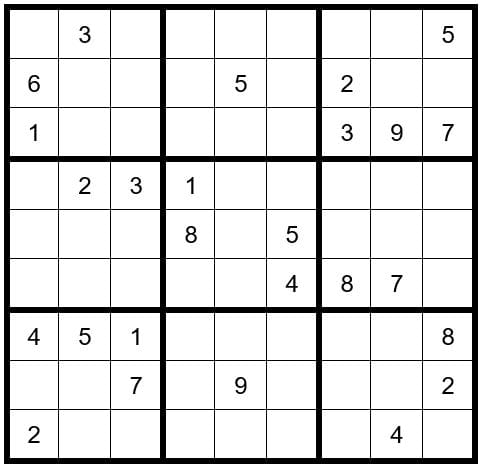


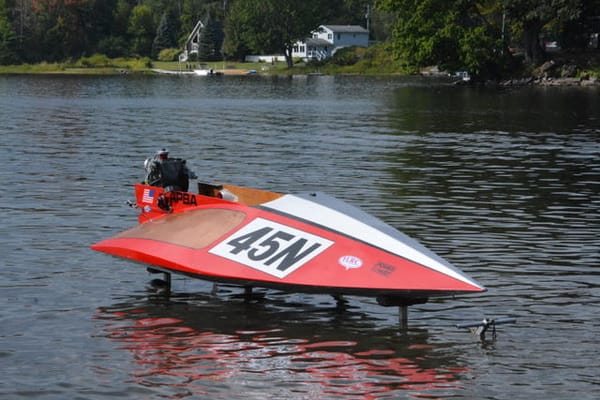
Please click here if you are unable to post your comment.